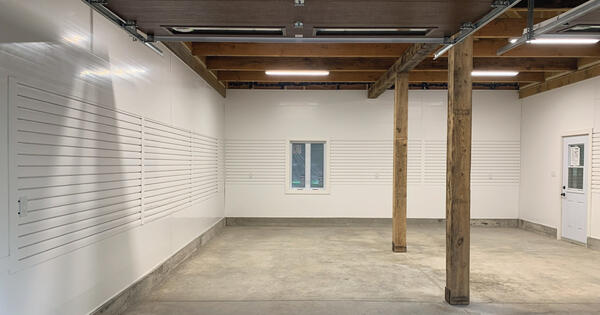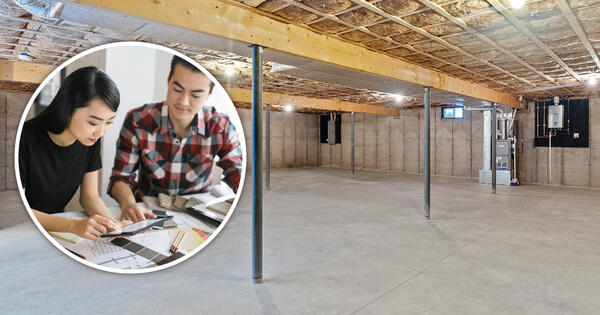this post was originally published in May 2025. Last updated: November 2025.
Whether you're hanging a set of floating shelves, installing new wall panels, or getting ready to knock down a wall for a renovation, understanding how far apart your wall studs are can make or break your project. Stud spacing plays a key role in how stable and secure anything attached to your walls will be — and it often reveals clues about how a home or garage was built.
In most residential construction, studs are placed at regular intervals to support drywall, insulation, and whatever fixtures you want to add later. But that spacing isn’t always the same. It can vary based on how the wall was built, whether it’s load-bearing or not, or if the space was finished by a homeowner instead of a builder. That’s why taking the time to figure out your stud layout is always a smart first step no matter what kind of project you’re planning.
What Are Wall Studs and Why Do They Matter?
Behind every finished wall is a hidden framework of vertical boards called wall studs. These studs act like the skeleton of the wall — they support the structure of the home and give you something solid to fasten drywall, electrical boxes, insulation, and heavy fixtures to.
In most homes, studs are either made of wood or metal:
- Wood studs are the most common in residential buildings. They’re usually made from softwoods like pine or fir and are relatively easy to work with using standard tools.
- Metal studs are more common in commercial settings, but they’re sometimes used in basements or garages because they’re fire-resistant and less prone to warping.
No matter the material, studs are responsible for keeping your walls straight, upright, and strong. They transfer the weight of the house from the roof down to the foundation and they’re also what keeps your heavy wall-mounted items from crashing down. Without knowing where your studs are (or how far apart they’re spaced), it’s a lot harder to make safe, lasting upgrades.


Standard Stud Spacing: What’s Typical?
While wall stud spacing can vary depending on when and where your home was built, most homes follow a fairly standard pattern. That consistency makes it easier to plan upgrades, repairs, and installations, but it’s still important to check the spacing in your specific walls before diving into a project.
Here are the most common stud spacing measurements you’ll find in residential construction:
- 16 inches on center (OC): This is the most common spacing in newer homes. “On center” means the distance from the center of one stud to the center of the next.
- 24 inches on center: This wider spacing is often used in exterior walls, garages, or homes built with advanced framing techniques to improve energy efficiency.
- 19.2 inches on center: Less common, but occasionally used for engineered wood or in custom construction projects.
Stud spacing isn’t just about layout, it’s often determined by the wall’s purpose. Load-bearing walls, which support the structure above them, usually follow a tighter spacing like 16 inches OC to handle the extra weight. Non-load-bearing walls, on the other hand, might have wider spacing since they don’t carry structural loads.
In garages, workshops, or unfinished basements, spacing can vary even more. Builders might follow different standards based on whether the space is meant to be finished or not, and DIY renovations sometimes introduce inconsistencies. That’s why measuring and confirming stud distance is always worth the effort.
16 on Center vs 24 on Center — Key Differences
16" OC and 24" OC refer to how far apart studs are, measured from the center of one stud to the center of the next.
| Feature | 16" On Center | 24" On Center |
|---|---|---|
| Typical Use Cases |
Most residential walls, load-bearing walls, ceilings |
Some basements, garages, older homes, mobile homes, interior non-load-bearing walls |
| Load Capacity |
Higher — supports heavier loads |
Lower — may flex more under weight |
| Energy Efficiency |
Slightly less (more studs = more thermal bridging) |
Higher efficiency potential |
| Material Requirements |
Uses more lumber and fasteners |
Uses fewer studs (cost-efficient) |
| Ideal For |
Mounting heavy items, supporting panels |
Wider spacing for cost or energy reasons |
Stud Spacing by Building Type
Stud spacing can change dramatically depending on the structure. Here’s a clear breakdown:
| Building Type | Typical Stud Spacing | Notes |
|---|---|---|
| Standard Residential Homes |
16" OC |
Most common spacing in modern builds. |
| Newer / Energy-Efficient Homes |
24" OC |
Reduces lumber, increases insulation space. |
| Garages |
16" or 24" OC |
Exterior walls often 24" OC; interior dividing walls 16" OC. |
| Basements |
24" OC common |
Especially in unfinished or partially finished spaces. |
| Mobile Homes |
16" or 24" OC |
Depends on manufacturer; interior walls may be 24" OC. |
| Older Homes (Pre-1960) |
Highly variable |
You may find 12", 14", 17", or 19" OC due to hand-built framing. |
How to Measure Stud Spacing Accurately
Before you start mounting shelves or planning where to cut into a wall, it's a good idea to measure the spacing between your studs. Thankfully, you don’t need to remove drywall or tear anything open — with the right tools and a bit of patience, you can figure it out from the surface.
Here’s what you’ll need to get started:
- A tape measure, ideally at least 25 feet long so you’re not limited by wall width.
- A stud finder, while not essential, makes the process a lot easier and more accurate.
- Painter’s tape or a pencil to mark stud locations as you go.
- A level or straight edge is optional, but helpful for marking vertical lines if needed.
To measure stud spacing without opening the wall:
- Start by finding your first stud. Use a stud finder or the tapping method (more on that in the next section).
- Mark the center of that stud. Use tape or a light pencil mark.
- Slide your stud finder horizontally. Mark each stud you find along the wall.
- Measure from the center of one stud to the center of the next. That’s your “on-center” measurement.
Keep going down the wall to see if the spacing is consistent. If you’re not getting a clear pattern — or if you’re not using a stud finder — try checking around outlets or switches. These electrical boxes are usually mounted to the side of a stud, which can give you a reliable starting point for measuring.



How to Find a Wall Stud
If you're planning to anchor something heavy to your wall, finding the studs is a must, and there are a few different ways to do it, with or without special tools.
When using a stud finder, follow these steps:
- Turn on the stud finder and calibrate it according to the instructions.
- Slowly move it across the wall in a horizontal line until it beeps or lights up.
- Mark the spot — this is likely the edge of a stud.
- Continue moving in the same direction until it beeps again — this marks the opposite edge.
- Find the center by measuring halfway between the two marks.
If you don’t have a stud finder, there are still a few tricks you can use:
- Look for electrical outlets or light switches. These are usually mounted on the side of a stud. Measure 3/4 inch to 1 inch from the edge of the box toward the center of the wall to find the stud.
- Tap on the wall. Hollow sections will sound more echoey, while solid areas over studs will sound duller.
- Use a small finishing nail or pin. In an out-of-the-way spot, gently poke through the drywall to feel for resistance from a stud.
Once you've located one stud, use your tape measure to check in 16- or 24-inch increments to find the others. Just make sure to confirm by checking for solid resistance or repeating your finder scan — don’t assume the pattern is perfect all the way across.
Why Stud Spacing May Vary
Even though most modern homes stick to standard framing practices, not every wall follows the rulebook. If your stud spacing isn’t exactly what you expected — or if it seems inconsistent from one wall to the next — you’re not alone.
There are a few reasons this might happen:
- Home renovations or additions: A wall might’ve been added or altered at a different time using different standards.
- Non-load-bearing or partition walls: These can be framed more loosely since they don’t carry structural weight.
- Framing adjustments around openings: Windows, doors, and plumbing can force builders to change stud layout to accommodate.
- Garage or basement construction: These spaces often have wider spacing, especially if they weren’t originally finished.
It’s also not uncommon to find studs that aren’t perfectly aligned, especially in older homes. That doesn’t mean there’s something wrong, but it does mean you’ll need to double-check measurements rather than rely on assumptions. Always verify spacing in multiple spots before cutting, drilling, or anchoring anything.
Common Mistakes to Avoid
When it comes to locating wall studs, a few simple mistakes can lead to a lot of frustration, or worse, structural damage or failed installations. The good news is most of these issues are easy to avoid with a bit of planning.
Here are some of the most common missteps homeowners make and how to steer clear of them:
- Assuming one measurement applies everywhere: Just because studs are 16 inches apart in one wall doesn’t mean every wall is built the same way. Always confirm the spacing in each area you’re working on.
- Measuring from the edge instead of the center: Wall studs are spaced “on center,” so you’ll want to measure from the middle of one stud to the middle of the next.
- Failing to double-check alignment: Stud finders aren’t perfect. If your marks don’t line up vertically or you’re getting inconsistent spacing, recheck the area to be sure you’re not being misled by pipes, wires, or framing quirks.
- Drilling too quickly: Driving screws or anchors before confirming the stud’s location can lead to weak installs or hitting something unexpected behind the wall.
If you’re not confident in your readings or can’t seem to find a stud where you thought one would be, take your time. Look at nearby features, compare measurements, and don’t be afraid to test a few spots with a small pin or drill bit. A few extra minutes of checking can save you from a major headache later on.
How Stud Spacing Impacts Wall Panel Installation
If you're planning to upgrade your walls — whether it’s for a finished garage, basement, or utility room — understanding stud spacing is key. The way your wall is framed directly impacts how you’ll install new materials, especially if you’re working with panels instead of traditional drywall.
Wall panels are often installed directly onto the framing, so the spacing of your studs affects both the stability of the panels and the ease of the installation. When studs are spaced correctly:
- Panels line up with attachment points which prevents sagging or buckling over time.
- Fastening is quicker and cleaner because you know exactly where to place screws or anchors.
- You reduce the need for extra materials like furring strips or added blocking.
Many wall panel systems — including some made of PVC or composite — are designed to be installed directly over standard 16" or 24" on-center studs. But if your spacing is inconsistent or exceeds those measurements, you may need to reinforce the wall to give the panels the support they need.
So before you start your project, double-check your stud spacing. It’ll save you time, make installation smoother, and help your panels perform the way they’re meant to.


Using Trusscore Wall&CeilingBoard with Standard Stud Spacing
Trusscore Wall&CeilingBoard is designed to work seamlessly with standard wall framing, making it a great option for both new construction and retrofits. Whether you’re installing directly onto wood or steel studs — or even over existing drywall — the system is built for flexibility, speed, and long-term performance.
If your walls are framed 16" or 24" on center, Trusscore panels can typically be fastened directly to the studs without additional materials. And because the panels are lightweight and interlock with a tongue-and-groove system, they’re fast and easy to handle — making installation cleaner and more efficient.
But what if your studs aren’t perfectly on center? That’s where a few simple adjustments come in:
- If your studs aren’t 16 inches on center, we recommend installing Trusscore vertically and adding horizontal strapping (also called furring strips) to ensure consistent fastening support.
- If your studs are spaced 24 inches apart or less, you can install Trusscore horizontally instead — which lets you fasten the panels directly to each stud without added blocking.
Here’s how to fasten the panels correctly, depending on orientation:
- For vertical installations: Use a screw every two feet along the length of each Trusscore panel or trim piece.
- For horizontal installations: Place a screw at each stud location, typically every 16 or 24 inches.
Trusscore is also compatible with a range of corrosion-resistant screws that are easy to source. Here's a breakdown of what to use depending on your wall type:
- Wood studs: #8 or #10 x 1-1/4” screws with a flat-bottomed, low profile head — such as round, washer, truss, pancake, or cabinet screws.
- Concrete walls: 3/16” x 1-1/4” flathead Tapcon screws.
- Metal or steel studs: Self-tapping #10 x 1-1/4” truss or pancake head screws.
- Stainless steel screws: Only required in high-moisture or corrosive environments.
No matter the surface, make sure your screws have a minimum head diameter of 3/8" to ensure a secure hold and clean finish.
Whether you're working with exposed studs or an existing drywall surface, Trusscore Wall&CeilingBoard adapts to your space and delivers a professional look — fast. For full installation tips and wall assembly recommendations, download the Trusscore Wall&CeilingBoard Installation Guide.
Understanding how your walls are built — especially the distance between studs — might not seem like a big deal at first. But whether you're mounting a shelf, hanging heavy gear, or upgrading your walls with a product like Trusscore Wall&CeilingBoard, knowing your stud spacing is a critical first step.
Troubleshooting Irregular Spacing
- Add furring strips to create consistent fastening points.
- Add blocking between widely spaced studs.
- Install panels vertically if horizontal spacing is inconsistent.
People Also Ask
Are studs always 16 inches apart?
No. While 16" OC is standard, many homes — especially basements, garages, mobile homes, and energy-efficient builds — use 24" OC. Older homes may have irregular spacing.
What does 16 on center mean?
It means each stud is spaced so the midpoint of one stud is 16 inches from the midpoint of the next. This ensures consistent load distribution.
How many inches apart are studs in most walls?
Most walls use either 16 inches or 24 inches on center. These are the two most common measurements in modern construction.
How to find studs without a stud finder?
Look for outlets, baseboard nails, corners, or measure 16" from a known stud. Most framing follows predictable spacing unless the home is older.
Why are studs 16 inches apart?
16" OC provides the best balance of structural strength and material efficiency, and aligns with standard panel sizes for drywall and wall systems.






